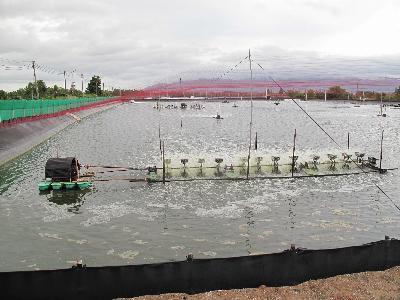Aeration with pond capacity, Importance of Aeration and Total oxygen budget in pond

Aeration:
Aeration is the process of adding oxygen to water and maintaining healthy levels of dissolved oxygen (DO) which is the most important parameters of water quality. Because aerobic type of respiration of living organisms only possible by DO.
This process will help you to create a perfect production of fish, caring of fish and finnaly a good output from you feed.
Carrying capacity
Every pond there is a particular carrying capacity; beyond the carrying capacity whatever you do fish production cannot be increased. Carrying capacity depends on many factors but dissolved oxygen is the vital one. Photosynthesis can occur in water column upto twice the depth the sun rays can penetrate in water depth. Sun rays penetration depends the water turbidity and dense phytoplankton condition in water. Ideally, sun rays can penetrate 1.2 m in water. So beyond 1.2 m water will be cooler. In this case aerator make low circulation and facilitates Oxygen mixing throughout the pond. So we can say aerator can increase carrying capacity of pond.
Importance of Aeration:
- Aeration is the process of adding oxygen to water and maintaining healthy levels of dissolved oxygen (DO)
- Aeration increases the level of dissolved oxygen so normal biological processes in a pond system can become balanced.
- It also helps to move water in low circulation and facilitates mixing throughout the pond if chemical treatment is necessary.
- The more decomposition we can facilitate, through the addition of oxygen with aeration.
- Aeration provides a way to clean up stagnant ponds and improve water quality for irrigation purposes.
- Decrease the severity of algae blooms and algae die-off
- Thermally and chemically destratify the water
- Allow for greater densities of fish.
- Reduce the amount of nutrients (N and P) and cause circulation currents that might create favorable conditions.
- Shift the level of carbon dioxide by venting it into the air, which could limit the amount available for plants..
Aerator capacity as per production target:
Aeration set up depends on what kind of production you want..?? Suppose production target, like each 250 kg biomass/ fish weight, 1HP electric motor capacity aerator or 2 paddle wheel aeration with 120 RPM (Rotation per minute) is necessary.
Aerator timing:
| 1st month | 8 hours |
| 2nd month | 10 hours |
| 3rd month | 12 hours |
| 4th month | 14 hours |
| 5th month | 14 hours |
30 min before feeding and 2.30 hrs after feeding aerator should be stopped. In following picture I showed, which species are responsible for Oxygen production and consumption and their their total percentage.
Factors influenced oxygen production and consumption
For better understanding the carrying capacity of a pond, we should calculate how much (%) oxygen is produced and which are responsible for oxygen consumption.

Oxygen producer
- Phytoplankton through photosynthesis process
- Diffusion ( Air and surface water interaction)
- Aerator
Oxygen consumer
- Phytoplankton respiration
- Fish and all zooplankton
- Bottom / sediment Decomposition
If we see the above picture, we can easily understand that phytoplankton are main producer of oxygen almost 70% and diffusion 10% and aerator only 20%. So if we do healthy plankton culture and concentrate no plankton die off no need aerator. Before setup an aerator we should first calculate is it cost effective or not..
Có thể bạn quan tâm
 Aquaculture Health Issues The Role of Biosecurity and Biotechnology
Aquaculture Health Issues The Role of Biosecurity and Biotechnology Disease outbreaks are being increasingly recognized as a significant constraint to aquaculture production, trade and are affecting economic development
 Aquaculture - disinfectants, sanitisers and feed supplements
Aquaculture - disinfectants, sanitisers and feed supplements Control of water quality is the key factor for a successful culture of aquatic animals like fish, prawn and shrimp. An open water system with sufficient good
 Liming and its Principles in Aquaculture
Liming and its Principles in Aquaculture The favorable influence of liming on fish/shrimp/prawn production in aquaculture ponds of soft and acid waters has been attributed to several of the effects